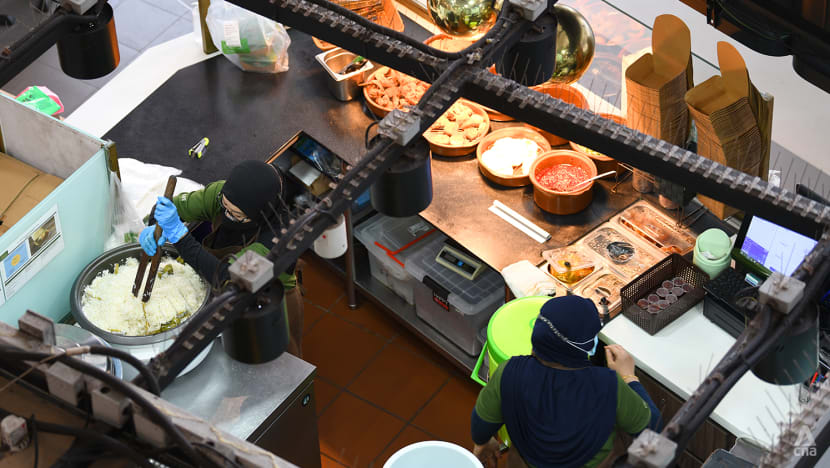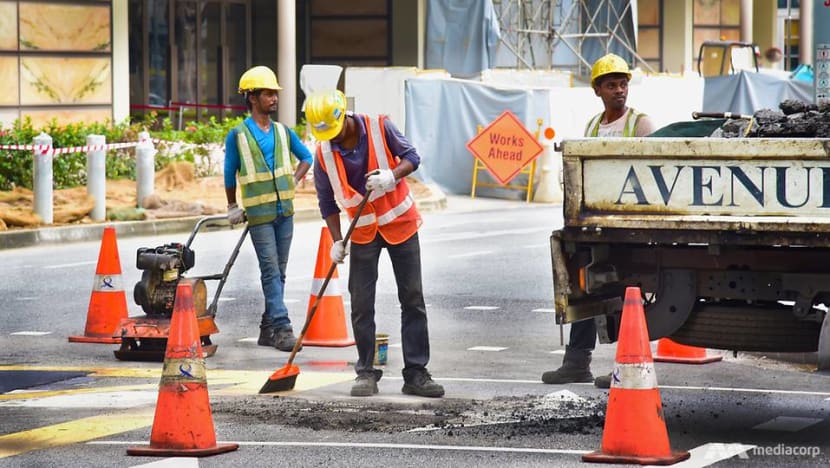S Pass qualifying salaries to be raised, but workers in some jobs can switch to work permits

F&B workers manning a stall in Singapore. (File Photo: CNA/Calvin Oh)
SINGAPORE: S Pass qualifying salaries will be raised to match the wages of local associate professionals and technicians, but workers in some jobs can switch to work permits, said Manpower Minister Tan See Leng on Friday (Mar 4).
The S Pass minimum qualifying salary will go up to S$3,000 this September, and further increases are planned for 2023 and 2025, as previously announced in Budget 2022.
The S Pass is for mid-skilled foreign employees performing specialised roles. The Ministry of Manpower (MOM) will set the benchmark for the cost of hiring an S Pass holder, which includes both the qualifying salary and levy, based on the top one-third of local wages.
The increase will be done in three steps, to moderate the impact to businesses, said Dr Tan during MOM’s Committee of Supply debate.
The exact salary values will be announced closer to the implementation date, based on prevailing local wages.

Tier 1 levies, which apply to up to 10 per cent of a company’s workforce, will also go up from S$330 to S$450 from September this year. It is expected to increase to S$650 by Sep 1, 2025.
“In addition to quotas, qualifying salaries and levies are in place to ensure that S Pass holders are hired because they fill skills gaps, and not simply because they are cheaper than locals,” said MOM.
JOBS EXCLUDED
But firms will be allowed to hire workers for some jobs on work permits once the higher salary benchmarks kick in on Sep 1 next year. This is as some firms hire rank-and-file workers on S Passes due to the source restrictions for work permit holders.
“We will introduce a Non-Traditional Source (NTS) occupation list, which is a tight list of rank-and-file occupations where employers will be allowed to hire NTS foreign workers on work permits,” Dr Tan said.
These include cooks in Indian restaurants, food processing workers, sheet metal workers, welders and flame cutters, riggers and cable splicers, and other such workers in manufacturing and engineering firms.
"I know many enjoy ... the multicultural cuisines in Singapore. I hope that this will reinforce our position as a food paradise supporting the cultural heritage of Singapore," said the minister.
These workers will need to be higher-skilled and be subject to a quota. They can also only perform the occupation stated on their work permit.
MOM will also introduce a Manpower for Strategic Economic Priorities (M-SEP) scheme, which provides foreign manpower flexibilities for a period of time to firms that contribute to Singapore’s strategic economic priorities and local workforce development.
To be eligible for the scheme, firms will have to meet criteria such as taking part in selected programmes for research and internationalisation. They will also have to commit to developing their local workforce.
The scheme will be available for three years and more details will be provided later.
CONCERNS ABOUT RAISING S PASS SALARIES
Dr Tan said there have been questions about whether increasing the S Pass qualifying salary means that foreign S Pass holders will automatically get a pay raise, perhaps at the expense of their local colleagues.
But if the S Pass salary is not raised, then local workers’ salaries will also stagnate, said Dr Tan.
"The firm can continue to renew the S Pass holder on the lowest salary required, so long as he is willing to accept it. And the firm will then have little reason to raise the pay for the other nine locals who are doing the same job."
He has also come across suggestions to load all the increase on levies. This will make the levy much higher, and apply equally to all S Pass holders.
“More productive firms that hire high-quality S Pass holders well above the qualifying salary, will face the same cost increase as less productive firms who are paying just the bare minimum,” said Dr Tan.
He added that the higher qualifying salary will only apply to work pass renewals from September 2023, and this could stretch out to 2026, depending on when the S Pass holder is due for renewal.
“The firm will have ample time to think about alternative options, for instance, finding or training up another local. This is especially so if the foreigner is not bringing enough value to justify the pay increase,” said Dr Tan.
He also pointed out that there are quotas at the S Pass level, but if employers still unfairly raise foreigners’ pay, without fairly reviewing the pay of locals, then workers can take their grievances to the Tripartite Alliance for Fair & Progressive Employment Practices (TAFEP).
To businesses that have said that it is hard to find locals in a tight labour market, Dr Tan urged them to redesign their jobs to make them more flexible and inclusive to attract local workers.
He pointed out that there is a “significant untapped supply” of manpower from women and seniors outside the labour force.
“With the S Pass moves, businesses that are reliant on low-cost S Pass holders will have to adapt. They will have to redesign their operations to become more productive. They will have to improve the pay and working conditions for these jobs. And because of this, they will be in a stronger position to attract locals,” he said.

TIGHTER QUOTAS FOR CONSTRUCTION, PROCESS SECTORS
A number of other changes to foreign manpower policy were also announced during Budget 2022.
The dependency ratio ceiling – the proportion of work permit holders a firm can employ – in the construction and process sectors will be reduced from the current 1:7 to 1:5 from Jan 1, 2024. And the current Man-Year Entitlement (MYE) framework will be replaced with a new levy framework.
The MYE framework refers to the number of work permit holders a main contractor can employ based on the value of projects or contracts awarded by developers or owners. It is allocated based on the number of “man-years” required to complete a project.
The new framework will lower the levy rates for off-site construction, and aims to support firms that adopt more productive technologies, said MOM.
Higher-skilled workers will continue to be subject to lower levy rates to encourage firms to employ skilled work permit holders.
The new levy rates will also encourage firms to diversify their workforce by hiring workers from Malaysia, China and North Asian sources, which have lower levy rates than workers from Bangladesh, India, Myanmar, Philippines, Sri Lanka and Thailand.
"COVID has shown us that it is not sustainable to continue to rely heavily on foreign manpower, especially at the semi-skilled level. Excessive reliance will leave businesses vulnerable to various disruptions," said Dr Tan.
"In order for our businesses to survive and thrive, they need to transform, increase their productivity, and reduce their reliance on work permit holders."















